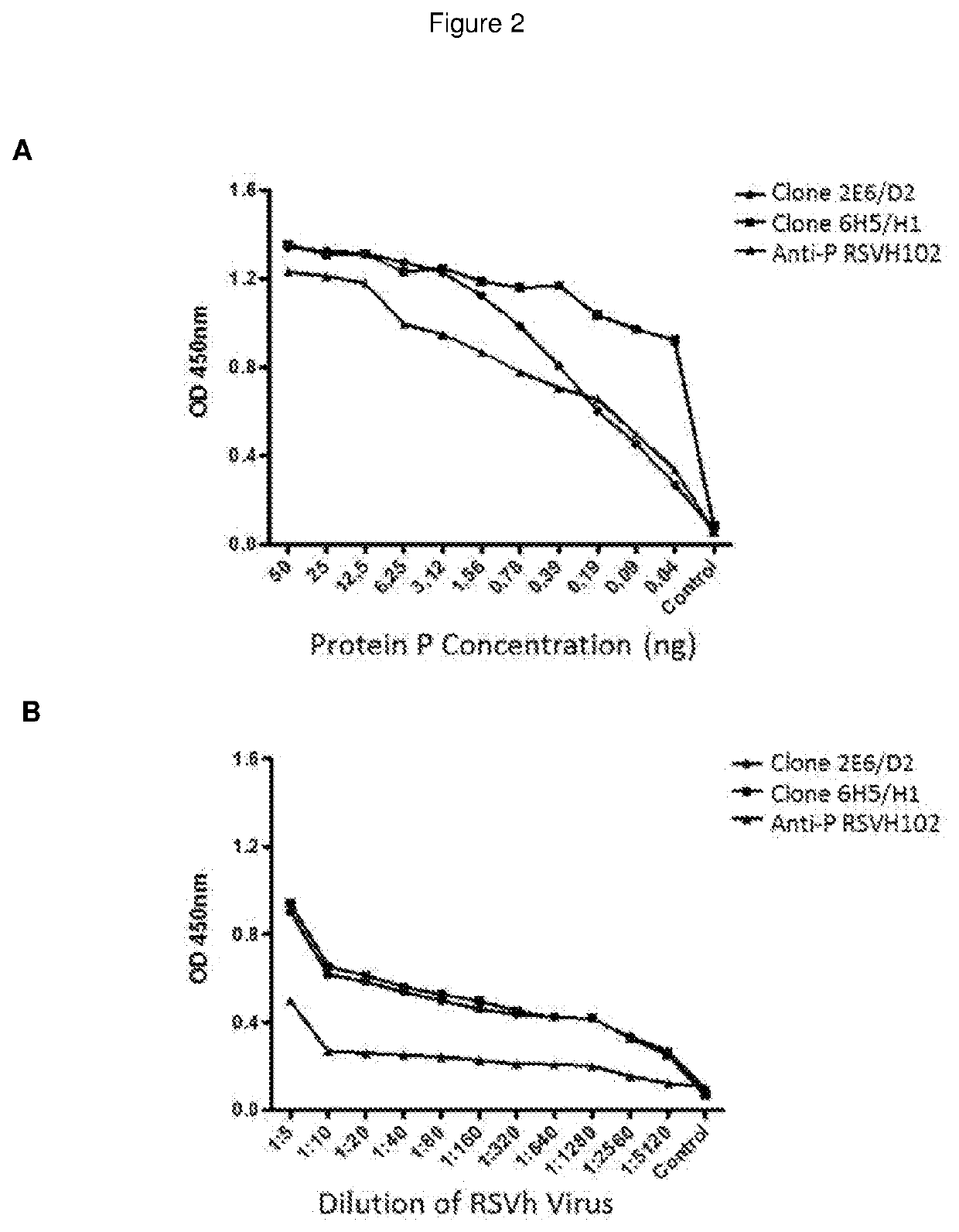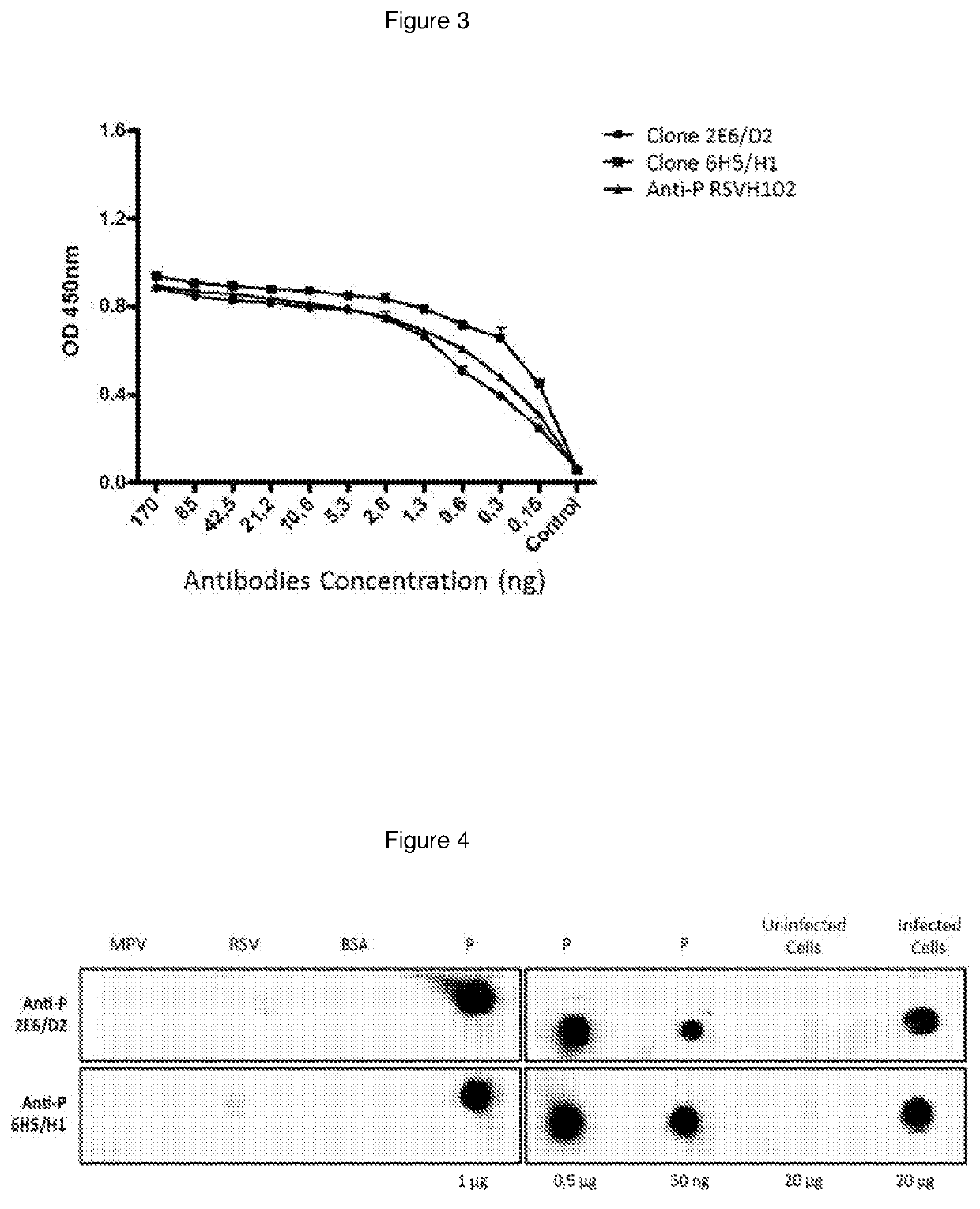Monoclonal antibodies specifically for the antigen P of the human respiratory syncytial virus, produced and secreted by the cells hybridomas, useful for detection and diagnostic of the infection caused by RSV
a technology of human respiratory syncytial virus and monoclonal antibodies, which is applied in the field of monoclonal antibodies, can solve the problems of not having effective prevention mechanisms, substantial economic losses, and public health problems, and achieve the effects of efficient protein p, low antigen availability, and increased detection sensitivity
- Summary
- Abstract
- Description
- Claims
- Application Information
AI Technical Summary
Benefits of technology
Problems solved by technology
Method used
Image
Examples
application examples
Example 1: Obtaining Purified RSV Protein P
[0029]For obtaining the purified RSV protein P, was performed an expression strategy of heterologous form (recombinant) in the bacterium Escherichia coli BL21. For this, the RNA was extracted of cell cultures HEp-2 infected with RSV and the gen, which encodes for the protein P was amplified by PCR and cloned in a bacterial expression vector (pET15b), which allowed controlling the gene expression cloned using the inductor molecule Isopropyl β-D-1-thiogalactopyranoside (IPTG). As purification strategy for recombinant proteins, the used expression vector possess an insert which encodes for six consecutive Histidines, so that when over-expression of the proteins was inducted, these expressed in their C-terminal end the 6 consecutives His. The advantage of using said energy is that, the protein acquires a characteristic electric charge, which allowed its purification through the affinity chromatography to a suitable pH. The purification of the r...
example 2
n of Hybridomas, Product of the Fusion of a Clone of Lymphocyte B and a Tumor Plasmatic Cell
[0031]The production of hybridomas was made using the mice immunization BALB / c with 1 mg of antigen (RSV purified recombinant protein P emulsified in adjuvant of Freund), with a purity greater than 50%. After the immunization, the mouse that presented the higher title of antibodies in the serum was selected, and it was given another booster injection. Three days after its splenic lymphocytes were isolated for making a somatic fusion with cells of the myeloid cell line NSO / 2 non-secreting. The hybridomas produced were seeded in 96-wells plates in a selective medium containing Hypoxanthine, Aminopterin and Thymidine (HAT). After 10 days the supernatant of the viable hybridomas was evaluated by ELISA for detecting antibodies against the antigen used for immunization. The positive hybridomas were expanded to 24-wells plates for generating a greater volume of supernatants, which later were used fo...
example 3
tion of the Nucleotide Sequence that Encodes the Light (VL) and Heavy (VH) Chains of the Variable Region of the RSV Anti-P Antibody Secreted by the Hybridoma 2E6 / D2 and of the RSV Anti-p Antibody Secreted by the Hybridoma 6H5 / H1
[0032]The following protocol was used for the hybridomas 2E6 / D2 and 6H5 / H1 separately. The hybridoma was grown in the middle of culture DMEM-high glucose supplemented with 3.7 g / L of Sodium Bicarbonate and 10% fetal bovine serum, to 37° C. with 10% CO2, until a cell density of 700,000 cells / ml. The total RNA of 3.5×106 cells was obtained, making a treatment with the Trizol (Invitrogen) compound. 0.5 μg of RNA was used for generating the cDNA using retrotranscription reaction with the Impron II (Promega) kit. Using PCR the variable region was amplified of the genes, which encode the kappa and lambda chains of the immunoglobulins. For this, the universal primers of the Ig Primer set of Novagen (catalogue number 69831-3) kit were used and the manufacturer instru...
PUM
| Property | Measurement | Unit |
|---|---|---|
| response time | aaaaa | aaaaa |
| concentration | aaaaa | aaaaa |
| cell density | aaaaa | aaaaa |
Abstract
Description
Claims
Application Information
 Login to View More
Login to View More - R&D
- Intellectual Property
- Life Sciences
- Materials
- Tech Scout
- Unparalleled Data Quality
- Higher Quality Content
- 60% Fewer Hallucinations
Browse by: Latest US Patents, China's latest patents, Technical Efficacy Thesaurus, Application Domain, Technology Topic, Popular Technical Reports.
© 2025 PatSnap. All rights reserved.Legal|Privacy policy|Modern Slavery Act Transparency Statement|Sitemap|About US| Contact US: help@patsnap.com



